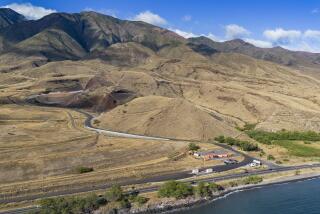$1-Million Cleanup of Toxic Dump Begins : Chatham Yard Project Starts With Little Fanfare After Years of Hassle
The morning mists rose in eerie shapes over the mounds of earth and lush green grass Monday as a cleanup crew assembled near the gate to the Chatham Brothers Barrel Yard. Here and there, a metal barrel stood, marked with a yellow label warning of its potentially toxic contents.
Little fanfare marked the long-awaited start to clean up San Diego Countyâs worst toxic dump in southwest Escondido.
Rod Cleem Jr., foreman of the American Environmental Management Co. crew, was nonchalant about the job ahead of him. Heâs seen worse.
The prospect of meeting up with snakes rattled him more than did the prospect of working among the contaminants.
âIâm a big chicken for snakes,â he admitted, precipitating a round of snake tales from his crew that didnât help his humor much.
35 Years of Waste
Cleem and his crew will be spending 10- and 12-hour days this week, scalping the growth off the site, on which 35 years of industrial wastes were dumped before environmental laws closed down the operation and mandated a thorough cleanup of the potentially cancer-causing deposits.
The men had reported for work at 5:30 a.m. at American Environmentalâs Stanton headquarters, loaded up their equipment, and headed down from Orange County to the Escondido site.
âWeâve got a good weekâs work ahead of us, cutting down trees and cutting the vegetation down to soil level,â Cleem explained. âI hear thereâs a pond out there . . . and a lot of snakes.â Again, he took some good-natured ribbing. âI didnât know there was barrels out here. Nobody told us about the barrels.â
The crew, armed with chain saws, weed eaters and a pint-sized bulldozer, huddled around the entrance to the site, awaiting orders from a representative of Ecology and Environment Inc., the main contractor for the cleanup work. Minutes passed, then hours, but the E & E supervisor didnât show up.
Finally Elaine Silvestro arrived and explained her tardiness. Her car had been broken into Sunday night and the tools of her trade--monitoring equipment--stolen. She had to round up another set and make the long drive down from her Los Angeles headquarters.
$1-Million Project
State Department of Health Services officials appeared for the inauguration of the yearlong, $1-million cleanup project.
Karen Baker, DHS project manager for Chatham, arrived early in her sporty Corolla with personalized license plates: DETOXIFY. This was her day. After years of planning and discussion and criticism from Chatham neighbors and local officials, the action plan was about to go into effect.
True, it is still a long way off from the actual removal phase when the buried wastes of the 1940s, â50s, â60s and â70s will finally be unearthed and removed.
Neighbors hardly raised an eyebrow Monday as they walked down their driveways and deposited their sacks and cans of trash.
Only Tom Chatham, one of the toxic siteâs owners, gave the group more than a glance. Chatham, who owns a home directly across the road from the property, is likely to be named as one of the responsible parties once the site cleanup costs are assessed and a cleanup plan adopted. That means that he may face a healthy bill from state attorneys for repayment of the costs now covered by the last of a $100-million state superfund. Chatham gave the group a long, hard stare, then turned and went indoors.
Passing motorists on narrow Bernardo Avenue slowed, more in an effort to avoid the parked cars and trucks along the road than to determine what was happening at the Chatham site, 16th on the stateâs list for toxic cleanup.
Too Early to Celebrate
John Kearns, regional chief of the stateâs Toxic Substances Control Division, and John Scandura, unit chief, explained that they had not expected a turnout of well-wishers at this point. But, wait until the final phase when the toxics--PCBs, heavy metals, petroleum distillates, etc.--are taken away. Then the local folks will cheer.
Cleem and his cohorts didnât don head-to-foot âmoon suitsâ to protect them during their labors. He explained that their work rated only Level D protection. On a danger scale of A (worst) to D (least), Chatham warranted only heavy rubber boots, coveralls, hard hats and a protective mask.
Site testing began at mid-day with Silvestro pacing the fenced-in enclosure with a small probe and read-out meter to measure gas levels. By the time the crew broke for lunch, no unpleasant readings had been registered.
Since the Chatham family bought the site at Bernardo and Gamble Lane in 1941 and the state found out about the industrial waste plant in 1981, small subdivisions have sprouted like wildflowers on the once-vacant rolling landscape.
In coming months, the new homeowners will have a front-row view as the remediation progresses, first with the improvement of the site, fencing of additional acreage, construction of a decontamination and testing area, off-site and on-site soil and ground-water testing to determine if the contamination has migrated off the site.
Next fall, a public hearing on the plan to remove the contamination will be held, followed by the removal of the wastes by late December or early January.
DHS officials say that they wonât know whether the Chatham site will ever become another Escondido subdivision until they determine the type and extent of the toxic materials hidden under the ground.
More to Read
Sign up for Essential California
The most important California stories and recommendations in your inbox every morning.
You may occasionally receive promotional content from the Los Angeles Times.










